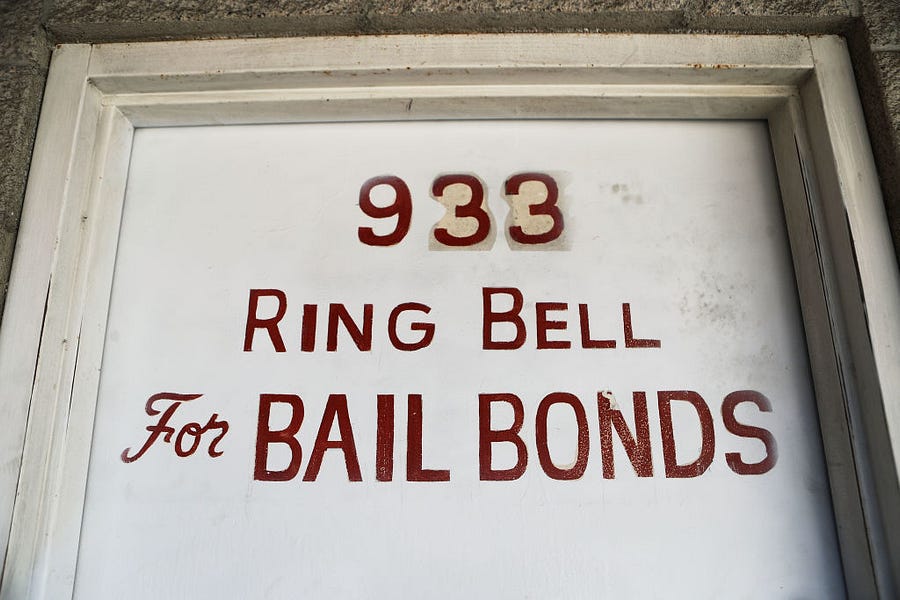As of mid-2021, only 20 percent of the U.S. jail population was serving time for being convicted of a crime. The rest were being held on pretrial detention.
That’s a result of the U.S. bail system. Despite increased calls for criminal justice reform—in a January 2022 Pew survey, 45 percent of Americans said that improving the criminal justice system should be Congress’ top priority—no reforms have succeeded at the federal level.
The most prominent effort came years before the renewed emphasis on criminal justice reform during the 2020 George Floyd protests, in a rare moment of common cause between libertarian Republican Sen. Rand Paul and then-Sen. Kamala Harris.
In 2017, the two introduced a bill to reform the bail system based on the contention that the current cash bail arrangement in most states was discriminatory, wasteful, and in part responsible for over-incarceration in the United States. The bill, the pair wrote in a New York Times op-ed, “would help restore Americans’ faith in our justice system” and save taxpayers billions of dollars a year.
But the “Pretrial Integrity and Safety Act” died in committee and similar efforts in the House by California Congressman Ted Lieu have also floundered. Potential changes to the bail system have nonetheless gained bipartisan traction at the state level, taken as the next logical step for a country interested in criminal justice reform, even as crime rises nationally. So how does bail work, and how might it fit into a larger effort to change the U.S. criminal justice system?
What is cash bail?
The U.S. justice system assumes innocence until prosecutors prove guilt in a court of law. Bail releases a defendant back into the public before trial to prevent the detention of innocent people and allow defendants time to prepare for trial—all while also trying to ensure public safety and court appearances.
The cash bail system, which dominates state court systems (cash bail is illegal for federal crimes), makes an upfront monetary payment the primary condition of release. Defendants pay a financial deposit to the court, to be returned when they appear for court dates. Those who cannot pay remain imprisoned until trial.
States vary in how they set bail, but generally each offense or class of offenses has a standard bail amount commensurate with the alleged crime—a system called a “bail schedule”—with judges often having leeway based on the circumstances of the case to decide the ultimate amount. Judges may also have discretion to deny bail and hold defendants until trial based on their perceived danger to the public or their relative flight risk. A judge may alternatively release the accused “on their own recognizance”—on their honor to return for their court date—or on the basis of supervised release, with regular check-ins with authorities.
The time served before a trial is not actually a penalty for the crime of which a defendant is accused. And that’s why many are clamoring for reform.
What are the effects of pretrial detention and cash bail?
Some argue that cash bail favors wealthy defendants who can buy their way out of pretrial detention and disadvantages poor defendants who may have to remain in jail until their trial —effectively criminalizing poverty.
An entire industry of for-profit bail bonds has developed around cash bail, targeted at defendants who cannot afford bail. To purchase a bond, the defendant pays a non-refundable fee—usually 10 to 15 percent of the full bail fee and capped by state law—often in regular, long-term installments to the bondsman, who pays the full bail to the court. When the defendant appears in court, the bondsman gets his money back and turns a profit.
Many bond agents may also require collateral, such as a car, home title, or other valuables in addition to the payment, to assure that the defendant returns to court and finishes paying off the bond. Should the defendant fail to appear in court, a “bail recovery agent,” or bounty hunter, has wide latitude in many states to find and return defendants.
A standard bail bond contract from one of the largest bond companies nationally, Lexington National Insurance, requires that defendants grant irrevocable permission for the bond agency to track their car and electronic devices digitally, enter any residence they suspect the defendant is in, without authorization, and consent to any use of force necessary to return the defendant to court if they attempt to skip bail.
The U.S. and the Philippines are the only two countries in the world where such a commercial bond industry is legal, though Oregon, Illinois, Wisconsin, and Rand Paul’s home state of Kentucky have all outlawed the sale of bail bonds. With cash bail still in place in some of these states, however, defendants who can’t afford their bail must remain in pretrial detention.
Critics of commercial bail bonds call them predatory, but bond agents call what they do a highly effective public-private partnership. Those in favor of the system point out that many government alternatives would require taxpayer money to achieve what they argue bail bonds already do: remove people from pretrial detention while also getting them back to court.
Yet, the collateral effects of pretrial detention on institutions and individuals are numerous and can be exacerbated by the cash bail system. Even a few days in jail can create serious instability for defendants—job loss, childcare uncertainties that could result in loss of parental custody, or missing doses of essential medications. Some studies show being unable to make bail can result in an increased likelihood of being charged with a crime later, and those effects are especially pronounced for those whose risk of recidivism was otherwise low.
Pretrial detention also favors prosecutors who want to cut a plea deal, because those held in pretrial detention have less consistent access to their lawyer and are in a more vulnerable position emotionally and physically than those who are released. Many defendants in pretrial detention could see pleading guilty, even if innocent, as the fastest way out of jail on “time served”—time spent in pre-detention included in the ultimate sentencing. This gives prosecutors the upper hand in plea negotiations. In practice, someone could sit in jail for months before taking a plea and only then be released, a reversal of the normal functioning of the system. Yet, so attractive is this option that research from the Department of Justice found that between 90 and 95 percent of all cases in the U.S. result in plea bargains.
Studies have indicated that longer stays in pretrial detention can increase sentencing severity among those found guilty, and that those effects are greatest for those charged with misdemeanors (and deemed to be the lowest risk to the public). Such defendants are more likely to be sentenced to time served—but it often ends up being longer than the sentence they would have faced for the misdemeanor itself.
Though the issue’s complexity makes it difficult to say with certainty, many studies have shown that black and Latino defendants were granted release less often and had higher bail amounts than white defendants, prompting many activists and reformers to point to cash bail as a discriminatory practice.
What reforms are on the table?
Harris and Paul’s 2017 bill offered grants to states to replace the cash bail system with a risk-based decision-making system for judges to determine a defendant’s eligibility for pretrial release. Though that bill failed, plenty of states—either through their court system or state legislatures—have moved toward reform efforts targeting different aspects of the bail system, with varying degrees of success.
Hawaii’s governor recently vetoed a bill that would have ended cash bail for most non-violent offenders. In Ohio, voters will decide in November on a ballot measure that would allow judges to consider public safety when setting bail amounts, potentially paving the way for an increase in pretrial detention, while a bipartisan bill that would de-emphasize cash bail moves through the Ohio House.
Reforms in New Jersey represent one model for a legislative solution to cash bail reform. Legislation that went into effect in 2017 followed the proposed Senate bill almost exactly. The Bail Reform and Speedy Trial Act, passed with the support of Republican Gov. Chris Christie, practically eliminated cash bail and instituted an algorithmic risk assessment tool to predict the risk of violence or flight for a defendant. The law changes the default to pretrial release instead of detention.The risk assessment uses nine factors that include age at the time of arrest and various measures of the defendant’s criminal history, such as previous convictions and court appearances, to come up with two scores. One score measures the likelihood that defendants will commit new crimes and the other measures the likelihood that they will make their future court appearances.
Supporters of the process lauded the risk assessment tool’s objectivity and focus on public safety, but some still worry that the algorithms could amplify or exacerbate the racial and economic biases of the original system.
In conjunction with bail reform, the legislation required a trial within 180 days of arrest in an attempt to limit pretrial jail time, to reduce the jail population, and to curtail the number of desperation plea bargains resulting from long periods spent in pretrial detention. The law authorized money for additional judges to make the short turnaround time feasible.
The law faced legal challenges almost immediately from multiple plaintiffs. Lexington National Insurance filed a class action suit naming a local plaintiff who after having been arrested in a bar fight, was released with an electronic ankle bracelet rather than being able to post cash bail as he would have under the previous law, resulting in what the suit called “severe deprivations of liberty.” Another suit took a different legal tack: A pro-bono law firm owned by Nexus, a company that furnishes bail to immigrants, represented a mother whose son had been killed by a defendant out on bail, a result of the new system. New Jersey won both cases.
The bills were successful at lowering the number of people in pretrial detention, while maintaining court appearance rates, though there is still a backlog in the courts leading to long wait times before trials.
Though proponents lauded the bill as a golden example of how bail reform could work, as gun violence has spiked in New Jersey and around the country, some have argued that bail reform is partly to blame. In response, in May, New Jersey lawmakers backed a bill that would keep those facing certain severe gun charges behind bars before their trial.
Illinois eliminated cash bail entirely with a law that won’t go into effect until 2023. The law will require that judges impose the least restrictive pretrial conditions that still ensure a defendant’s appearance in court. It goes further than the New Jersey law by allowing the defense lawyer to have access to the defendant’s risk assessment score for it to be debated in an adversarial hearing. The law also has provisions that order courts to offer pretrial services like court date reminders and transportation to and from court.
Legislative reform isn’t the only way to change the cash bail system—the courts, too, have been a venue for change. In 2020, the Nevada Supreme Court ruled that bail could be set for a defendant only if the prosecutor could prove “by clear and convincing evidence that it is necessary to ensure the defendant’s presence at future court proceedings or to protect the safety of the community, including the victim and the victim’s family.” In practice, this places the burden of proof on the prosecution to illustrate why the defendant should be kept in pretrial detention, making release the default, rather than detention.
In 2021, California’s Supreme Court, too, decreed judges must consider the defendant’s ability to pay when setting bail, and an inability to post bail could not be the only factor keeping a defendant in jail. The ruling told judges to favor release over the use of cash bail; other conditions of detention, like time in a rehab or community living facility, or monitored release with an ankle bracelet could stand in the gap. California voters rejected a law put to them on the ballot in 2020 that would have eliminated cash bail entirely in the state.
Reforms can start even smaller. At the local level in Detroit, Michigan’s largest district court settled a class action lawsuit by agreeing to put in place rules forcing Detroit judges and magistrates to go on the record stating how setting cash bail would protect the public or mitigate the risk of failure to appear. The settlement also establishes standards to avoid exorbitant bail amounts for the poorest defendants.







Please note that we at The Dispatch hold ourselves, our work, and our commenters to a higher standard than other places on the internet. We welcome comments that foster genuine debate or discussion—including comments critical of us or our work—but responses that include ad hominem attacks on fellow Dispatch members or are intended to stoke fear and anger may be moderated.
With your membership, you only have the ability to comment on The Morning Dispatch articles. Consider upgrading to join the conversation everywhere.